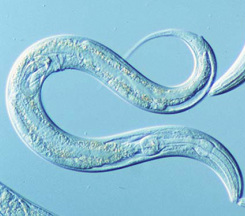In 2003, the Human Genome Project successfully completed the mapping of the entire human genome. Since then, genetic research has sky-rocketed. One of the most useful applications of genomics is comparative genome mapping, wherein we can look at the susceptibility genes for different conditions. That's incredible in itself, but what scientists are starting to do now is compare pathologies of different diseases and the genes associated with them. In Alzheimer's research, scientists have looked at illnesses such as diabetes and Downs Sydrome to study their genetic links with Alzheimer's.

A gene has been found which suggests a link between diabetes and Alzheimer’s. People with type 2 diabetes have an increased risk of dementia. In diabetes, insulin resistance affects the metabolic processes of the body, including those of the nervous system. Researchers at The City College of New York studied the APL-1 gene in the nematode worms C.Elegans. APL-1 is an APP-related protein that seems to disrupt the insulin pathway. When scientists removed APL-1 from the worms, the worms died. Although the exact function of APP is not clear to scientists, this study suggests that it may be involved in the insulin processes of the nervous system.
-*-
Slight side track - C. Elegans worms are seriously cool.
Nobel prize winner Sydney Brenner discovered these worms in his backyard compost, and quickly realised how useful they would be as scientific models. One of their most useful features is their transparency, making them easily observable in microscopy. They're small, easily maintained and have a very simple anatomy of which scientists understand in its entirety. They exist in two sexes - male and hermaphrodite, and scientists can use these hermaphrodite worms to create millions of genetically identical models in a short space of time. Their anatomy, surprisingly, also has similarities to humans. They have an intestine, skin, muscles, reproductive organs and a nervous system. Although this nervous system consists of only 302 neurones, these neurones are very well described. They also use the same neurotransmitters as humans do (such as dopamine and acetylcholine). And even more surprisingly, scientists have actually discovered how to teach learning and memory in these worms so they can be studied for diseases like Alzheimer's. In fact, the presenilin genes (PSEN-1, PSEN-2) that were discussed in the last blog post were discovered through work done with these worms.
Yep, pretty awesome for something that could be digging around your compost right now...
-*-
Sufferers of Down’s Syndrome are also known to have an increased risk of developing Alzheimer’s. For sufferers in their 60s, the risk can be as high as 50%. They also tend to develop the disease much earlier (between 40-50 years old). Down’s Syndrome is a chromosomal condition based on the trisomy of chromosome 21; the same chromosome where the APP gene is located. Scientists reason that the presence of the third chromosome 21 causes the overproduction of APP and therefore increases the formation of amyloid beta plaques.
It's clear that genes do play some role in the development of Alzheimer's, as family history of the disease can increase an individual’s risk significantly. However, it’s also clear that environmental factors must also account to some extent for the majority of cases which cannot be attributed to genetics alone. More information on the environmental factors of Alzheimer’s in the next blog post!
References
Alzheimer’s Society, 2008. Genetics and Dementia [online] Available at <http://alzheimers.org.uk/site/scripts/documents_info.php?documentID=168> [Accessed 14 July 2012]
City College of New York, 2012. Gene May Link Diabetes and Alzheimer’s, CCNY Researchers Find [online] Available at: <http://www1.ccny.cuny.edu/advancement/news/Gene-May-Link-Diabetes-and-Alzheimers.cfm> [Accessed 13 July 2012]
USF Health, 2010. Studies implicate damage inflicted by amyloid protein as shared disease mechanism [online] Available at: <http://hscweb3.hsc.usf.edu/health/now/?p=9843> [Accessed 17 September 2012]
UCTV, 2011. The Aging Brain: Frontiers of Neuroscience in Health and Disease, Frontiers in the Biology of Alzheimer’s Disease and Other Dementias. Available at: <http://www.uctv.tv/shows/Frontiers-in-the-Biology-of-Alzheimers-Disease-and-Other-Dementias-21372> [Accessed 3 February 2013]
Alzheimer’s Society, 2008. Genetics and Dementia [online] Available at <http://alzheimers.org.uk/site/scripts/documents_info.php?documentID=168> [Accessed 14 July 2012]
City College of New York, 2012. Gene May Link Diabetes and Alzheimer’s, CCNY Researchers Find [online] Available at: <http://www1.ccny.cuny.edu/advancement/news/Gene-May-Link-Diabetes-and-Alzheimers.cfm> [Accessed 13 July 2012]
USF Health, 2010. Studies implicate damage inflicted by amyloid protein as shared disease mechanism [online] Available at: <http://hscweb3.hsc.usf.edu/health/now/?p=9843> [Accessed 17 September 2012]
UCTV, 2011. The Aging Brain: Frontiers of Neuroscience in Health and Disease, Frontiers in the Biology of Alzheimer’s Disease and Other Dementias. Available at: <http://www.uctv.tv/shows/Frontiers-in-the-Biology-of-Alzheimers-Disease-and-Other-Dementias-21372> [Accessed 3 February 2013]

 RSS Feed
RSS Feed